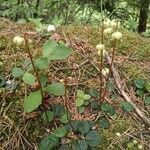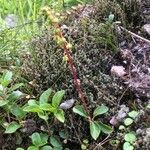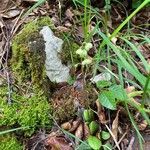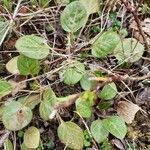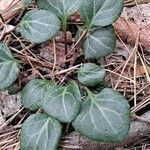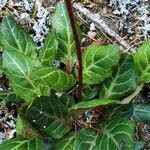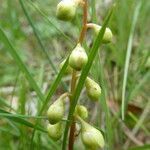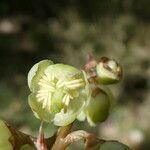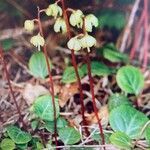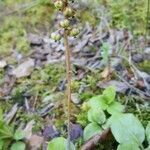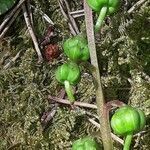Herbs 11–18 cm tall. Rhizome long, slender, branched. Aboveground stem very short. Leaves 2–4, basal; petiole 2–5 cm; leaf blade pale abaxially, dark green adaxially, rather dull, suborbicular, 1–1.6 × 1–1.2 cm, leathery, base rounded to acute, margin minutely crenulate, apex rounded. Scape including inflorescence 10–20 cm high, usually with a solitary scale; raceme laxly 2–8-flowered, slightly nutant, nodding, 1.5–3.5 cm. Pedicel 4–5 mm; bracts lanceolate. Flowers cup-shaped, ca. 1 cm in diam. Sepals triangular-ovate, ca. as long as wide, 1–1.5 mm, basal widest 1–1.5 mm, apex ± acute or obtuse. Petals greenish white, ovate or elliptic, 5–6 mm. Filaments dilated at base; anthers yellow, oblong, mucronate at distal end; tubules curved, pores oblique. Style exserted, longer than petals, strongly bent, somewhat thickened upwards, dilated at apex into ring. Capsule ca. 6 mm in diam. Fl. Jun, fr. Aug.
Lvs 1–3(–4) cm, often shorter than the petiole, obovate to broadly elliptic or subrotund, rounded to truncate at the summit, rounded to broadly cuneate at base but scarcely decurrent, seldom ± reduced or even wholly suppressed; scapes 1–2.5 dm, seldom with more than 10 fls; sep broadly ovate-triangular, broader than long, obtuse or subacute; pet 4–9 mm, white, ± veined with green; anther-tubes abruptly narrowed from the pollen sacs and of different color, prolonged 0.6–0.8 mm and usually separate, often curved; style declined; 2n=46. Dry woods; circumboreal, in Amer. s. to Md., W.Va., Ind., and the w. cordillera. June–Aug. (P. virens; P. oxypetala)
